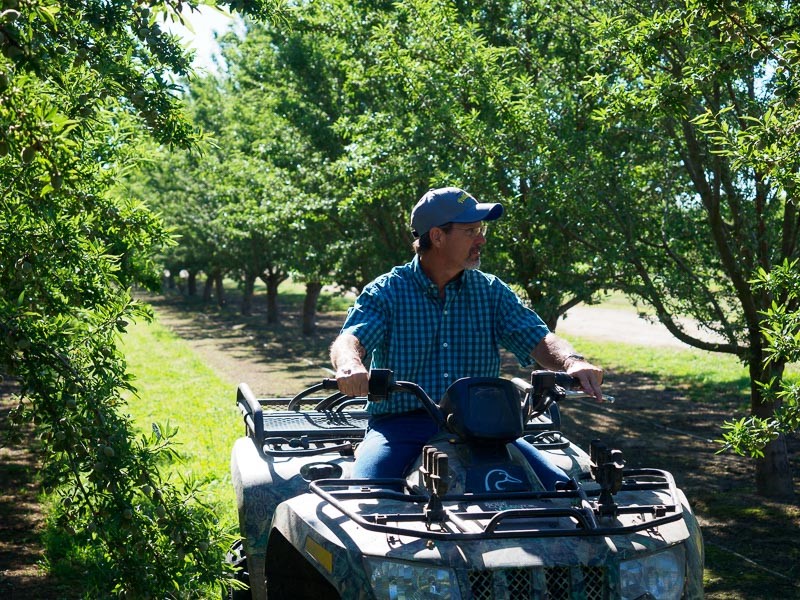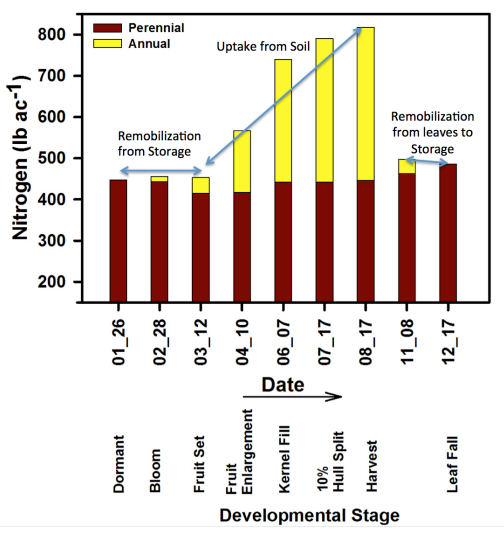When it comes to applying nitrogen fertilizer, the decisions almond growers make really matter — to the environment and their bottom line.
“Nitrogen use efficiency is very important for growers,” said Patrick Brown, professor of Plant Sciences at the University of California, Davis. “You want that nitrogen you paid for to go into your crop, not be wasted, or lost to the groundwater.”
Fortunately, decades of research and collaboration between the University of California and the Almond Board of California (ABC) have produced practical guidelines and tools to assist growers, increasing their chances for a successful crop while minimizing impacts to the environment.
 When almond irrigation and nitrogen applications are managed carefully, optimal yields can be achieved while still realizing 70% nitrogen use efficiency.
When almond irrigation and nitrogen applications are managed carefully, optimal yields can be achieved while still realizing 70% nitrogen use efficiency.
Growers increasingly in spotlight
While growers are always focused on efficient crop production, they should be also be aware of increasing regulatory attention to groundwater quality and pressure on all farmers to improve performance in the area of nitrogen use efficiency, said Gabriele Ludwig, director of Sustainability and Environmental Affairs for the Almond Board.
In the Central Valley, growers are regulated under the Irrigated Lands Regulatory Program, which is beginning to set limits on the amount of nitrogen that can be applied to a certain area based on townships. While those limits are still being developed, now is a good time for growers to keep close track of their nitrogen applications and strive for greater efficiency to stay ahead, Ludwig said.
“The spotlight on nitrogen management is not going to go away,” she said.
A few simple rules
Top experts state that nitrogen use efficiency can be achieved if growers follow a few key guidelines and pay attention during the peak nitrogen uptake season, from March through May. Among the most important of these guidelines:
- Determine your orchard’s expected demand using available tools (see below), then apply frequently and incrementally, adjusting during the season based on plant tissue testing to assure the right rate of nitrogen is applied at each key growth stage;
- Check your irrigation system to make sure everything is always working properly — nitrogen use efficiency requires irrigation uniformity;
- Add the nitrogen toward the end of the irrigation set when fertigating to keep more nitrogen from being moved deep in the rootzone, too far away from most of the active roots. Mid to -later in the irrigation set fertigation injections allow the fertilizer nitrogen to stay higher in the soil profile where the roots can get to it;
- Avoid early or late applications (before bloom or after harvest) because trees aren’t taking up nitrogen at those time; and
- Check the weather to avoid applying nitrogen right before a significant rain, which would likely flush some or all of the nitrogen below the root zone before the tree can use it.
With more growers using fertigation, properly managed irrigation is more vital than ever for efficient water and nitrogen use. That means checking to make sure the system is evenly applying water throughout the block and that lines, pumps and sprinklers are all working properly.
“I encourage growers to check for irrigation uniformity and apply nitrogen toward the end of the irrigation cycle to promote high efficiency,” said Sebastian Saa, ABC’s senior manager for Agricultural Research.
And, especially earlier in the season, growers should keep an eye on the weather, Saa said.
“Especially in sandy soils, if you know it’s going to rain the next day, that is not the best time to apply,” Saa said. “You want to try to avoid leaching; you want the nitrogen to go into the tree instead of wasting your money and losing it.”
Not too early, not too late
Experts say growers should be estimating their crop’s nitrogen demand as early as January, based on a five-year average of previous yields and fruit set. The California Almond Sustainability Program (CASP), which provides helpful tips and opportunities for growers to improve on-farm practices, includes a Nitrogen Budgeting Calculator that allows growers to input orchard specific data and then provides a total nitrogen fertilizer recommendation, along with recommended amounts by crop growth stage.
 Avoid early or late applications (before bloom or after harvest) as trees aren’t taking up nitrogen during those times.
Avoid early or late applications (before bloom or after harvest) as trees aren’t taking up nitrogen during those times.
The Calculator, along with ABC’s Nitrogen Budgeting tool, also provides growers with the necessary paperwork for submitting nitrogen budgets to their Irrigated Lands Regulatory Program coalition.
While planning is helpful, growers must ensure they do not apply nitrogen too early — it is wasteful and unnecessary.
“You want to wait until the bees are moved out of the orchard and you are into petal fall,” said Franz Niederholzer, a University of California Cooperative Extension farm advisor specializing in orchard systems.
Research has shown that prior to petal fall, mature trees provide their own nitrogen from inner storage to get growth started — and couldn’t use nitrogen even if it were available in the soil. Research has also shown that late applications of nitrogen — especially well after harvest — do not help the trees, are wasteful and likely will no longer be available in the soil by spring.
“Limited trials suggest there is no yield benefit the following year from late nitrogen applications,” Niederholzer said.
Adjustments needed, but timing important
While nitrogen applications pre-bloom or post-harvest don’t help the crop, a lot can be done in-season to adjust applications to meet crop demand.
Following the pre-bloom estimate, growers can use tissue sampling in April to assess nitrogen levels in the tree, and they can input a revised yield estimate to adjust remaining nitrogen applications, as needed.
Niederholzer said additional leaf samples in July can help a grower determine whether they are running short on nitrogen in an orchard and therefore determine whether additional applications are needed.
“Too much [nitrogen] isn’t going to help, and too little leaves money on the table,” Niederholzer said.
When almond irrigation and nitrogen applications are managed carefully, optimal yields can be achieved while still realizing 70% nitrogen use efficiency — higher than many other crops, according to Brown.
Tools for growers
Tools, calculators and important information regarding nitrogen applications are available for free to growers at Almonds.com/Growers. A few key webpages dedicated to nutrients are listed below. Growers with questions regarding nitrogen management can email ABC’s Sebastian Saa at ssaa@almondboard.com.